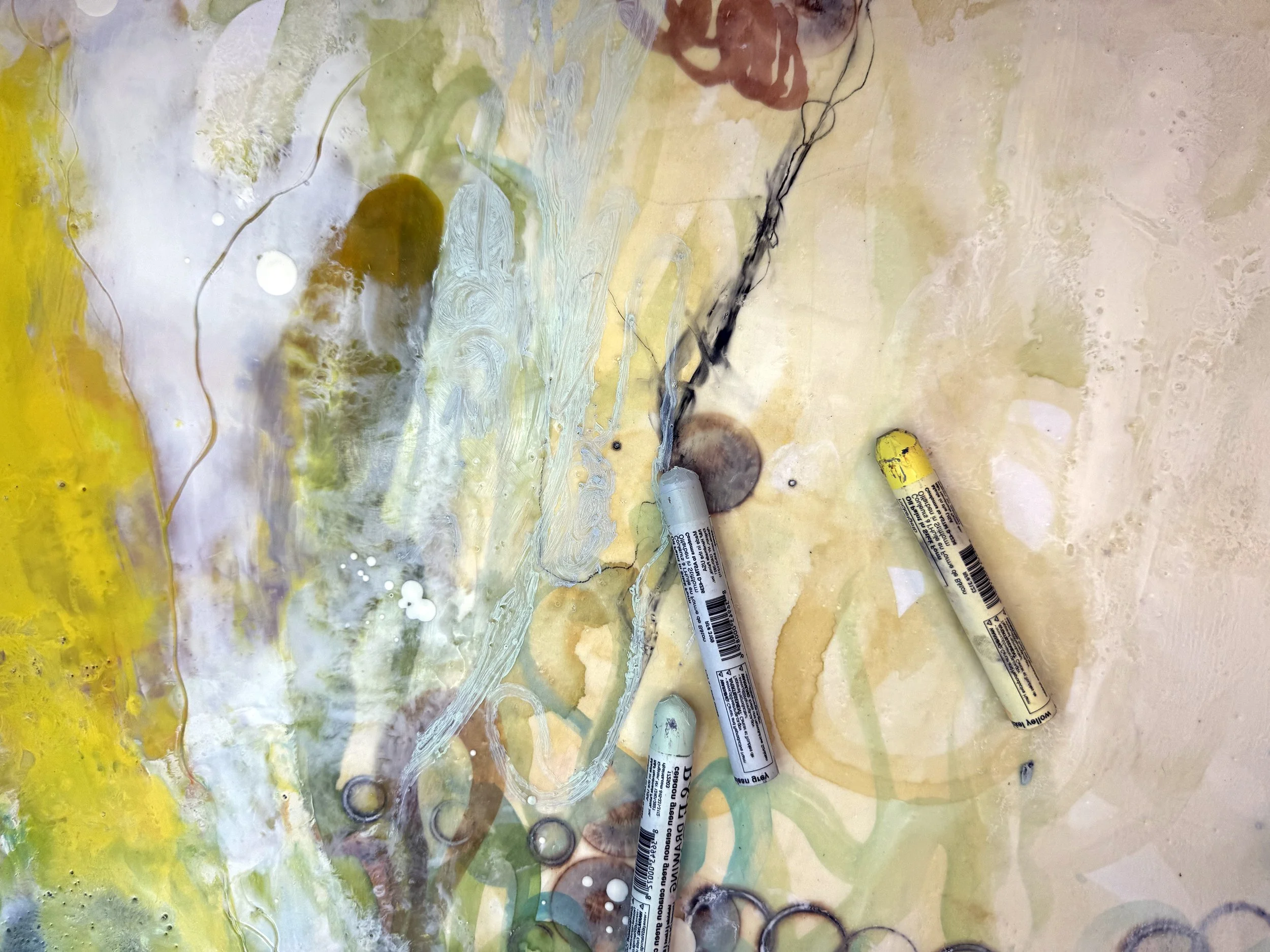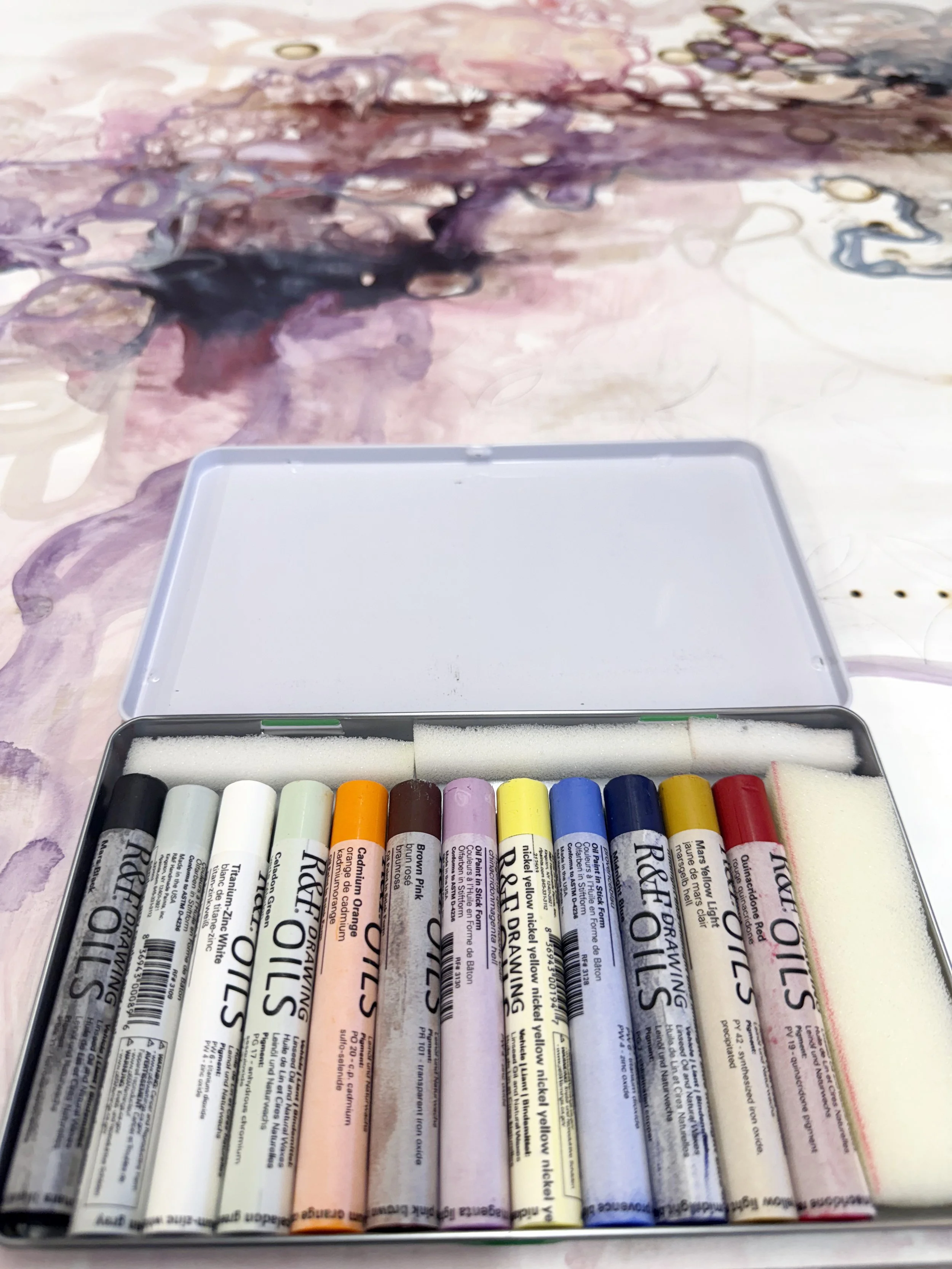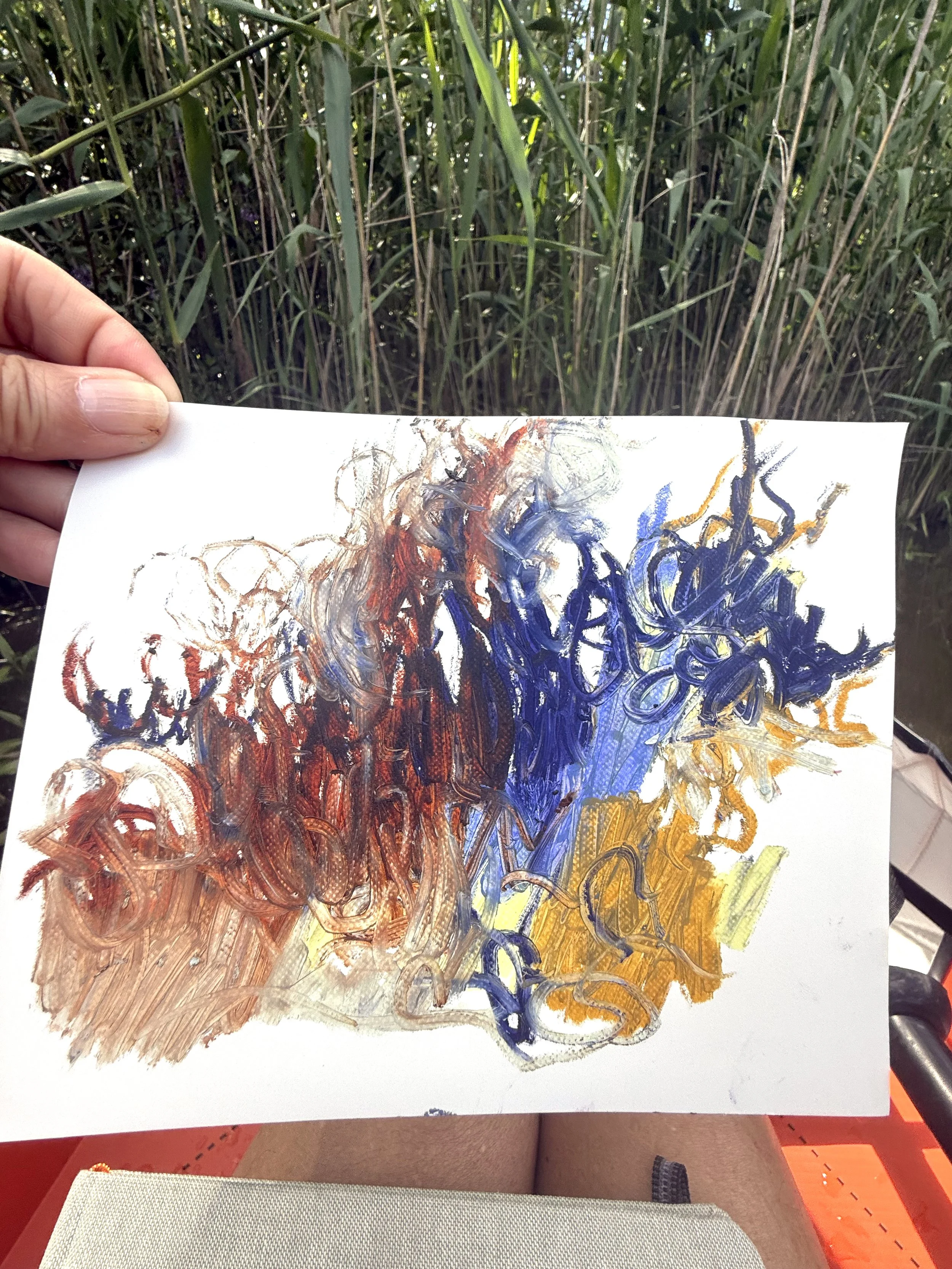My R&F Drawing Oils Experience
If you know my work, it’s likely you don’t associate it with oil pastel drawings or oils in general. However, secretly, I did have a brief love affair with oil pastels back in 2017, the year I traveled and taught more than any other. I had been searching for something portable that I could both draw and paint with that was neither a pencil or a paint and didn’t need anything special to make it work. During one of my retreats that year, a participant had a box of oil pastels and she let me try them, I was hooked! I loved how they mixed like paint, how smooth they would glide across the page, how I could apply other media in combination with them without worry and they were portable. As soon as I was home, I went straight to the art supply store and tried out some of the oil pastel samples. Of course, the ones I settled on were Sennelier, the most expensive in the store, but the quality was definitely worth the expense. In comparison to the other brands, Sennelier had the richest color and the smoothest touch on the page. I loved how they mixed together in such a lovely way without getting chalky and crumbly like the cheaper ones. A few weeks later, I went on a 2 months trip out west, traveling and teaching in the Utah dessert, California and Oregon. I made so many drawings with my new oil pastels and enjoyed the process immensely. But just like any other love affair that begins too quickly, I began seeing the cracks rather soon…my new love definitely had some deal-breaker flaws. The biggest flaw was that my drawings never dried and neither did the pastels themselves…I mean, never! I had the pastels in my backpack and had to take extra care not to let them touch anything, they were such a sticky mess. Once I was home, I removed the smeared messy drawings from my sketchbook and let them sit out for months, yet they still remained tacky. Disgusted, I ended up throwing them out and gifting the oil pastels to my sister. The love affair was over and the search continued for the perfect portable drawing/paint media.
Fast forward to 2025, when I heard about the new R&F Paints Drawing Oils, I couldn’t wait to try them-but, I had been burned before so I was skeptical. As soon as I received and played with them a few minutes, I knew they were the product I had searched for back in 2017. They have the superior color, smoothness, workability and portability I found with the Sennelier brand, but this time….the drawings dried in a very reasonable time and so do the oils themselves, making them my most favorite portable paint.
Whenever I receive a new product, I want to try everything all at once. My first experiments were to try out the drying process on various substrates and then take them out in my kayak to test portability. R&F recommends working on Encausticbord for the best results, but I prefer to draw on something smoother, I just love the way these Drawing Oils glide. I tried them on Yupo, Mineral Paper, Encausticbord, Mixed Media Paper and a gessoed encaustic surface. This is clearly not an exhaustive list of substrates, but I wanted to experiment with substrates that would work best for me. Read on for my notes, each substrate’s drying time, along with some scribbly photos. Keep in mind, I’m a bit rusty and was just playing around, so be kind :))
Needless to say, these oils are a dream come true. My Drawing Oils are my constant companions, especially out on the road, on the trail and in my kayak. Because I love to share on this blog, I dug up photos of my old drawings from 2017, mostly of the desert landscape, storms and a few of the PNW and California beaches. Scroll down for the gallery of these drawings. Looking at them again, I’m intrigued with the minimal way in which I handled the compositions and the complementary line work. I’m so inspired to collect every color of the Drawing Oils and draw everything in sight!
If you’re curious and want more information about this fabulous new product, I encourage you to visit R&F’s website, Unique Color Blog, Youtube Channel and Instagram.
Substrates and Drying
Please note that these experiments were conducted in my studio in Philadelphia at the end of April to June. My studio is in the attic, with no air conditioning and Philly is humid this year! I also tend to work very thickly in layers, pressing down hard and then making marks with silicone tipped tools and blending stumps. In some cases, I layered back into the Drawing Oil marks while they were still tacky or even completely dry-this is my favorite thing to do as the colors still blend very well, but are easier to control. All this to say that your drying results may differ from mine depending on your location and working process. Regardless, the Drawing Oils are designed to dry and be super fun no matter what.
Mixed Media Paper
This was the first substrate I tried on the day that I received my new Drawing Oils. The marks were made on top of a watercolor ink monotype on April 23 while it was still relatively cool, but humid in my studio. I touched the drawing everyday and by the third day, it was not wet but still tacky and remained slightly tacky until May 3 when the marks were completely dry (about 10 days). As it stands now, almost 3 months later, the drawing is still completely dry and the marks have not reconstituted in the humidity as some products will.
Yupo
My go-to for oil pastels in 2017, I couldn’t wait to see what these Drawing Oils would feel like on the super smooth Yupo surface and I was not disappointed. They glide, blend and look lovely on the bright white surface. Layering is best when the first few layers are slightly tacky-this gives the subsequent layers something to grab onto. I started this drawing on April 24 and this one took a bit longer to dry completely on May 7-may have been the humidity and/or the substrate, but it’s still dry 3 months later.
Mineral Paper
I do enjoy working with Yupo, but the plastic thing bothers me as I prefer natural materials whenever possible. I discovered Mineral Paper a few years ago and it’s an excellent substitute. This paper behaved and dried exactly like the Yupo, see above for an explanation.
Encausticbord Plain
As I mentioned, I do enjoy a smooth surface when working with this media, but I wanted to test the drying time on the Encausticbord as R&F recommends that the boards work best as a surface for the Drawing Oils….and they were right! I did find that it took the oils about 9 days to dry completely at a very humid time in May. Also, because of the toothy surface, I was able to layer a bit better than on the smooth surfaces. Rubbing strong undertone colors like Brown Pink into the surface brought out the the light pink and peachy tones Brown Pink is known for. Half of the Encausticbord I used had encaustic on it, so I had a smooth and toothy surface contrast.
Gessoed Wood with Encaustic Surface
I’ve been working on a large commission all summer that began as a wooden painting panel covered in 2 layers of R&F Encaustic Gesso and many layers of encaustic. As I was painting in the background, I just needed a little something different to add texture to the surface and the Drawing Oils were just the trick. I didn’t wait for the marks to dry, I just fused and continued to work. The Drawing Oils also mix well with Woody crayons on the encaustic surface. Super fun!
Portability
Once I established that the drawings would dry, I wanted to try out the portability of the Drawing Oils and how well would they work in the sun in my kayak. Just a side note, I’m a hoarder of small tins and boxes and I just happened to have one that fit the drawing oils perfectly, along with a few blending stumps. This box helped keep the oils organized and most importantly, from getting too melty in my backpack.
I packed a few pages of mineral paper and away I went to my favorite kayaking pond to sit and draw. It was a lovely, relaxing experience and the oils held up in the sun just fine. One thing I forgot was a small drawing board that I will pack that next time. I ended up using the cover of my sketchbook, which has a slight texture that the oils picked up that I think is kind of unsightly. To keep my drawings from becoming smeary, I packed a few sheets of wax paper and this worked perfectly. Once home, I put the drawings on my drying rack and they dried completely in about 10 days. I highly recommend them for drawing out on the trail or wherever your wanderlust takes you.
Drawings of the Utah desert landscape, storms and PNW/California beaches. All drawings made with Sennelier Oil Pastels, mixed media on paper, 2017.



























